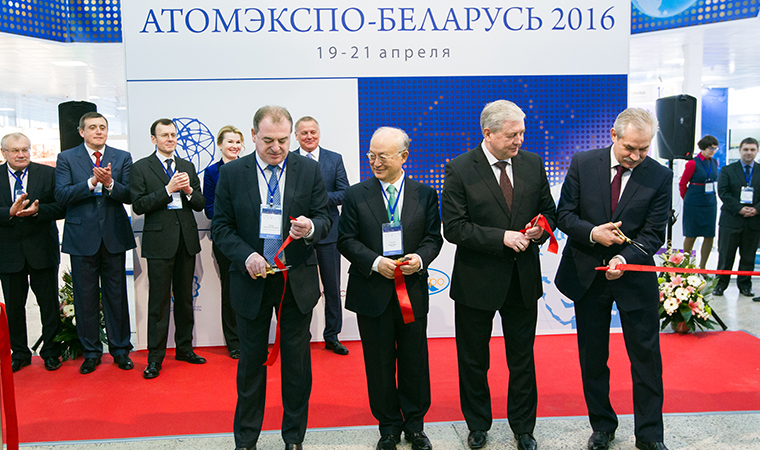
Showcase project
back to contentsThe Russian-designed Belarusian NPP, now under construction near the town of Ostrovets (Belarus), is seen by the IAEA as one of the most successful civil nuclear projects in emerging nuclear countries. “The two-unit nuclear station, which is now built in Ostrovets, is one of the most effective nuclear construction projects in the countries yet developing their nuclear industry. The IAEA provides comprehensive support for the project and stays in contact with Belarus in developing civil nuclear power,” Yukiya Amano noted.
Conference participants were welcomed by Vladimir Semashko, First Deputy Prime Minister of Belarus, who said in his speech, “The nuclear plant construction in Ostrovets is a very important national project that will diversify energy sources in Belarus, which is currently dependent on oil and gas. The project runs as planned and will contribute to the improvement of national science and technology.”
After the opening ceremony, Yukiya Amano visited the construction site where work is going full tilt. The turbine is being installed in the turbine island of Unit 1. The reactor building of Unit 1 is almost prepared for the installation of a reactor vessel – right now, a vehicle airlock is being constructed in the reactor island. Last year the reactor vessel was delivered to the site of Unit 1 to mark an important stage of the project. This year the vessel will be placed in its permanent position. A cooling tower for Unit 1 has been completed while the other for Unit 2 is still under construction. The on-site training center has already opened its doors to would-be nuclear station operators who are doing here their preparatory training course. “The construction goes in line with the schedule; the first reactor will be definitely ready for the startup by 2018,” assured Vladimir Gorin, a deputy chief engineer for staff training at the Belarusian NPP. By the end of 2016, it is planned to install a reactor vessel and a pressurizer, construct external containment walls up to Level +44.600 and the internal containment dome up to Level +67.800, and begin the assembly of steam generators.
It should be mentioned that local construction and installation companies are engaged in the project to the maximum extent possible. As at the end of 2015, 83.6% of construction and installation was done by Belarusian contractors. The Belarusian NPP, exactly as Rosatom’s other projects abroad, creates many new jobs for the locals.
Appreciated by IAEA
Over 30 reporters from different countries were waiting for Yukiya Amano after a tour round the site. “When I came to Belarus 4 years ago, the construction had not started yet. Today I am very much impressed with the progress achieved,” Amano said. “The way the construction process is organized here has also made a great impression on me.” Yukiya Amano called Belarus a valuable partner of the IAEA and stressed that his visit would strengthen cooperation between the parties. “We were pleased to see the country’s commitment to the strictest nuclear safety standards during the visit,” the IAEA Director General stressed.
According to him, cooperation between the IAEA and Belarus intensifies and it is the country’s initiative to invite IAEA experts to its nuclear sites. “Belarus welcomes IAEA missions and proves its close involvement in the global nuclear community,” Yukiya Amano underlined this fact in his speech.
In 2012, the IAEA sent an expert mission to assess the nuclear infrastructure as part of the national nuclear sector development. “We made recommendations and defined strengths and weaknesses of the Belarusian nuclear facilities. Today we see clearly that the country strictly follows the IAEA guidelines,” Amano noted with satisfaction. According to him, the IAEA will send seven more missions to Belarus before the commissioning of Unit 1 in 2018. “Our mission in October will analyze activities of Belarus’ national nuclear regulator Gosatomnadzor. To develop the nuclear power industry, it is vital to have an independent regulator,” Yukiya Amano said. There will be another mission to assess safety and readiness of the nuclear station right before the reactor startup.
It was announced at the Forum that there was nothing to prevent the project from meeting its deadlines. Vice Premier Vladimir Semashko stressed that the construction was going in accordance with the schedule. “We plan to start up the first reactor by the end of 2018, followed by the second unit in 2020,” he said.
For reference:
Constructed near Ostrovets, a small town in the Grodno Region of Belarus, the Belarusian nuclear power plant will feature two VVER-1200 reactor units with a total capacity of 2,400 MWe. The nuclear power plant is based on the standard Generation 3+ design that offers more efficient performance and advanced safety systems compliant with post-Fukushima requirements, as well as full compliance with applicable environmental and sanitary regulations.




